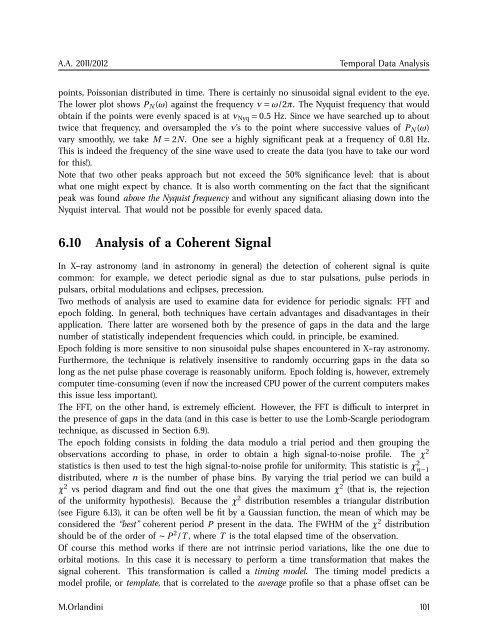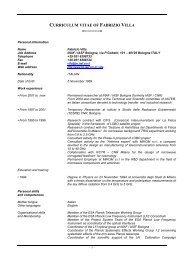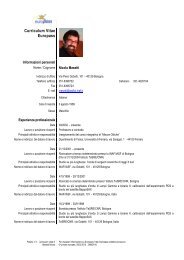booklet format - inaf iasf bologna
booklet format - inaf iasf bologna
booklet format - inaf iasf bologna
You also want an ePaper? Increase the reach of your titles
YUMPU automatically turns print PDFs into web optimized ePapers that Google loves.
A.A. 2011/2012<br />
Temporal Data Analysis<br />
points, Poissonian distributed in time. There is certainly no sinusoidal signal evident to the eye.<br />
The lower plot shows P N (ω) against the frequency ν = ω/2π. The Nyquist frequency that would<br />
obtain if the points were evenly spaced is at ν Nyq = 0.5 Hz. Since we have searched up to about<br />
twice that frequency, and oversampled the ν’s to the point where successive values of P N (ω)<br />
vary smoothly, we take M = 2N. One see a highly significant peak at a frequency of 0.81 Hz.<br />
This is indeed the frequency of the sine wave used to create the data (you have to take our word<br />
for this!).<br />
Note that two other peaks approach but not exceed the 50% significance level: that is about<br />
what one might expect by chance. It is also worth commenting on the fact that the significant<br />
peak was found above the Nyquist frequency and without any significant aliasing down into the<br />
Nyquist interval. That would not be possible for evenly spaced data.<br />
6.10 Analysis of a Coherent Signal<br />
In X–ray astronomy (and in astronomy in general) the detection of coherent signal is quite<br />
common: for example, we detect periodic signal as due to star pulsations, pulse periods in<br />
pulsars, orbital modulations and eclipses, precession.<br />
Two methods of analysis are used to examine data for evidence for periodic signals: FFT and<br />
epoch folding. In general, both techniques have certain advantages and disadvantages in their<br />
application. There latter are worsened both by the presence of gaps in the data and the large<br />
number of statistically independent frequencies which could, in principle, be examined.<br />
Epoch folding is more sensitive to non sinusoidal pulse shapes encountered in X–ray astronomy.<br />
Furthermore, the technique is relatively insensitive to randomly occurring gaps in the data so<br />
long as the net pulse phase coverage is reasonably uniform. Epoch folding is, however, extremely<br />
computer time-consuming (even if now the increased CPU power of the current computers makes<br />
this issue less important).<br />
The FFT, on the other hand, is extremely efficient. However, the FFT is difficult to interpret in<br />
the presence of gaps in the data (and in this case is better to use the Lomb-Scargle periodogram<br />
technique, as discussed in Section 6.9).<br />
The epoch folding consists in folding the data modulo a trial period and then grouping the<br />
observations according to phase, in order to obtain a high signal-to-noise profile. The χ 2<br />
statistics is then used to test the high signal-to-noise profile for uniformity. This statistic is χ 2 n−1<br />
distributed, where n is the number of phase bins. By varying the trial period we can build a<br />
χ 2 vs period diagram and find out the one that gives the maximum χ 2 (that is, the rejection<br />
of the uniformity hypothesis). Because the χ 2 distribution resembles a triangular distribution<br />
(see Figure 6.13), it can be often well be fit by a Gaussian function, the mean of which may be<br />
considered the “best” coherent period P present in the data. The FWHM of the χ 2 distribution<br />
should be of the order of ∼ P 2 /T , where T is the total elapsed time of the observation.<br />
Of course this method works if there are not intrinsic period variations, like the one due to<br />
orbital motions. In this case it is necessary to perform a time trans<strong>format</strong>ion that makes the<br />
signal coherent. This trans<strong>format</strong>ion is called a timing model. The timing model predicts a<br />
model profile, or template, that is correlated to the average profile so that a phase offset can be<br />
M.Orlandini 101

















